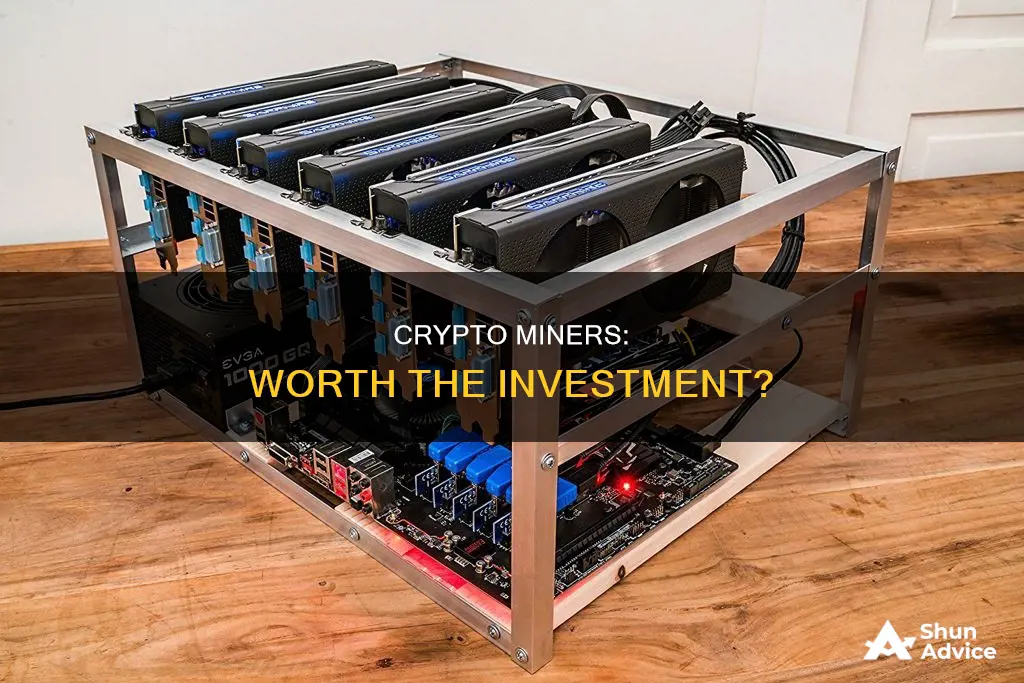
Crypto mining is the process of creating cryptocurrencies by auditing and processing transactions on the blockchain. Crypto miners verify data blocks on the blockchain and add the next block or record of transactions to the chain. Crypto miners are rewarded with Bitcoin or other cryptocurrencies when they solve complex calculations. Crypto mining has evolved from being performed on home computers to requiring significant capital investment in processing power and electricity to complete the calculations. The profitability of crypto mining is determined by hardware costs, energy prices, and the price of cryptocurrency. While crypto mining can be profitable, it is important to consider the costs and risks involved.
What You'll Learn

Crypto mining stocks vs. buying crypto directly
The Pros and Cons of Each
There are several factors to consider when deciding between investing in crypto mining stocks and buying crypto directly. Both options have their own unique set of advantages and disadvantages, and the best choice for you will depend on your individual circumstances and investment goals.
Crypto Mining Stocks
Investing in crypto mining stocks means purchasing shares in companies that are engaged in the business of mining cryptocurrencies. These companies typically have large-scale mining operations with specialised equipment and access to low-cost electricity. One of the main advantages of investing in crypto mining stocks is that you can gain exposure to the cryptocurrency market without actually having to purchase any crypto directly. This can be appealing if you are hesitant to enter the volatile crypto market. Additionally, mining stocks can offer more stability compared to the often-volatile crypto market. For example, Wall Street analysts have favoured mining stocks over cryptocurrencies during periods of crypto market decline, as they believe the fundamentals of mining companies remain strong.
However, it is important to remember that the performance of mining stocks is still closely tied to the price of the cryptocurrencies they produce. For instance, a potential increase in interest rates can negatively impact both crypto prices and the profitability of mining operations, leading to a decline in mining stock prices.
Buying Crypto Directly
On the other hand, buying crypto directly means purchasing cryptocurrencies such as Bitcoin or Ethereum through an exchange or broker. This option offers more flexibility and control over your investment. You can choose to buy or sell crypto instantly at the market price or set limit orders to automate your trades. Additionally, buying crypto directly can provide access to decentralised finance (DeFi) opportunities and the potential for higher returns compared to mining stocks.
However, buying crypto directly also comes with higher risks. The crypto market is known for its volatility, and the value of your investment can fluctuate significantly. Bitcoin mining, for example, has become increasingly competitive, making it difficult for individual miners to turn a profit. Additionally, there are various costs associated with mining, such as equipment and electricity, which can eat into your profits.
Both crypto mining stocks and buying crypto directly have their advantages and disadvantages. Investing in crypto mining stocks may be a better option if you want exposure to the crypto market while reducing the risks associated with direct crypto ownership. On the other hand, buying crypto directly offers more flexibility and control, but it comes with higher risks and volatility. Ultimately, the decision between the two depends on your investment goals, risk tolerance, and personal preferences.
Best Sites for Crypto Investment: Where to Invest?
You may want to see also

Crypto mining profitability
One of the critical factors affecting profitability is the cost of electricity to power mining machines. Crypto mining requires significant computational power, which can result in high energy consumption and electricity costs. Miners need to consider their energy sources and the impact of energy price fluctuations on their overall profitability.
The speed and efficiency of the mining hardware also play a role in profitability. More advanced and efficient mining systems can process transactions faster and, therefore, have a higher chance of earning rewards. The initial investment in such systems can be substantial, with prices ranging from a few hundred to several thousand dollars for competitive ASICs (Application-Specific Integrated Circuits).
Another factor to consider is the difficulty level of mining a particular cryptocurrency. As more people engage in mining, the difficulty increases, making it harder to earn rewards. This is where mining pools come into play. Joining a mining pool allows individuals to combine their resources and increase their collective chances of earning rewards. However, the rewards are then distributed among the pool participants, and fees may apply, impacting overall profitability.
Market conditions, such as the price of the cryptocurrency and the network hash rate, also influence profitability. When the price of a cryptocurrency surges, mining can become more profitable, especially for those using the proportional mining payout method, where rewards are directly proportional to the effort expended. On the other hand, when cryptocurrency prices are low, the pay-per-share method may be more advantageous, as it guarantees a flat fee regardless of the pool's performance.
Overall, prospective crypto miners should carefully consider their options and perform a comprehensive cost-benefit analysis before investing. While crypto mining can still be profitable, the landscape has become more competitive, and the potential rewards may not be as high as they once were.
Bitcoin: A Good Investment or Risky Bet?
You may want to see also

Hardware costs
Crypto mining hardware can be expensive, with some of the most profitable ASIC Bitcoin miners costing thousands of dollars. For example, the Bitmain Antminer S21 Hyd 335T, currently the most profitable Bitcoin mining machine, costs $4,200+, while the Bitmain Antminer KS3 (9.4Th) starts at $12,000+.
The cost of a mining rig will depend on its hash rate, power consumption, and cooling system. A dedicated mining system with a higher hash rate will be more expensive to run, as it will have higher power consumption. Water cooling is quieter and more efficient than fan cooling but is also more costly to run.
When purchasing a mining rig, it is important to consider the return on investment (ROI). Prospective miners should calculate how long it will take to pay back the initial investment through crypto mining, taking into account electricity costs and other expenses such as space, infrastructure, internet, and maintenance.
In addition to the cost of the mining rig itself, other hardware costs include motherboards, coolers, and storage. These additional components can add several hundred dollars to the overall cost of a mining setup.
Given the high costs involved, it is crucial for prospective miners to perform a cost-benefit analysis before investing in crypto mining hardware.
Losing More Than You Invested: The Crypto Risk
You may want to see also

Energy prices
The energy consumption of cryptocurrencies has been a topic of concern for governments, investors, and the general public. Bitcoin, the world's largest cryptocurrency, currently consumes an estimated 150 terawatt-hours of electricity annually, more than the entire country of Argentina. The energy-intensive nature of crypto mining has led to concerns about its impact on electricity grids, potential increases in electricity prices, and carbon emissions.
In the United States, the rapid growth of cryptocurrency mining operations has drawn the attention of policymakers and grid planners. The primary operating cost of a cryptocurrency mining facility is electricity expenditure. As a result, owners are constantly seeking ways to acquire substantial amounts of power at the lowest possible cost. This has led to concerns about the strain on electricity grids, especially during periods of peak demand, and the potential for higher electricity prices for consumers.
Some cryptocurrency miners have located their facilities near existing power plants or suppliers of low-cost electricity, such as hydroelectric dams or natural gas wells, to minimize electricity costs. However, the increased demand associated with cryptocurrency mining can still present challenges to the operation of electricity grids, and there are concerns about the reliability of Bitcoin miners as participants in demand-response programs.
The energy consumption of cryptocurrency mining has also raised concerns about carbon emissions and climate change. Bitcoin mining emits an estimated 65 megatons of carbon dioxide into the atmosphere annually, comparable to the emissions of Greece. The shift of mining operations from China to the United States after China's crackdown on digital currencies in 2021 has also led to an increase in the share of natural gas and coal-powered plants used for Bitcoin mining, further contributing to emissions.
To address these concerns, there have been calls for the crypto industry to transition to more sustainable energy sources and reduce its carbon footprint. Some companies, such as Hut 8 Mining Corp. and TeraWulf Inc., have made efforts to use emission-free or zero-carbon energy sources for their operations. Additionally, there are campaigns such as "Change the Code, Not the Climate" by Greenpeace and the Environmental Working Group, which aim to motivate Bitcoin to move away from energy-intensive consensus mechanisms.
While the energy consumption of cryptocurrency mining is a complex issue, it is clear that addressing it is crucial for the long-term sustainability of the industry and the planet.
The Ultimate Bitcoin Investment Research Guide
You may want to see also

Crypto price
The profitability of crypto mining depends on several factors, including hardware costs, energy prices, and the price of the cryptocurrency being mined. Crypto mining has become more challenging over time, as it requires significant capital investment in processing power and electricity to complete complex calculations.
Some analysts argue that buying cryptocurrencies directly is a better investment strategy than investing in crypto mining stocks. This is because mining companies need to bear operational and capital expenses, which can eat into profits. When crypto prices rise, mining companies have to pay more for electricity and equipment upgrades, reducing their margins.
Crypto mining profitability is also affected by the difficulty level of mining a particular cryptocurrency. With Bitcoin, for example, the reward is halved every four years, and serious miners have built large arrays to mine, making it harder for smaller miners to compete.
Overall, while crypto mining can be profitable, it is a high-risk, high-reward investment. Crypto prices play a crucial role in determining the profitability of mining operations, but other factors, such as hardware and energy costs, should also be considered.
Yale University's Crypto Investment: Millions in Digital Currency
You may want to see also
Frequently asked questions
Crypto mining can be a profitable investment, but it is complex and comes with many challenges. Crypto mining is an energy-intensive process that requires significant capital investment in processing power and electricity. The profitability of crypto mining depends on various factors, including hardware costs, energy prices, and the price of cryptocurrency.
The three key factors that determine a crypto miner's profitability are hardware costs, energy prices, and the price of cryptocurrency. Crypto mining requires significant capital investment in high-end semiconductors, and the cost of chips can fluctuate. Additionally, miners need to find cheap sources of energy to run their computations, and the price of cryptocurrency can impact the stock prices of mining companies.
Crypto mining involves auditing and processing cryptocurrency transactions to verify data blocks on the blockchain, the digital public ledger that underpins cryptocurrencies like Bitcoin. Miners solve complex calculations to earn rewards in the form of Bitcoin or other cryptocurrencies. The computations require extremely powerful computers, and the process is energy-intensive.
Crypto mining can be challenging due to the high upfront costs, including expensive hardware and graphics cards, as well as high power consumption. The difficulty of Bitcoin mining also increases over time, making it harder for smaller miners to compete. Additionally, the market for cryptocurrencies is volatile, and there is a risk of losing money if the value of the cryptocurrency drops.
To get started with crypto mining, you need to invest in a powerful computer system or join a mining pool. You can build a crypto mining rig with components like a motherboard, power supply, and a GPU card. It is important to perform a cost-benefit analysis considering factors such as setup costs, electricity costs, and the price of cryptocurrency before investing in crypto mining.







